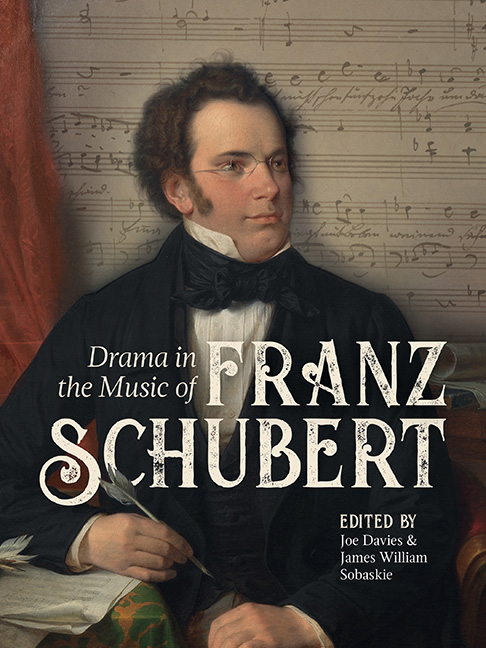Book contents
- Frontmatter
- Dedication
- Contents
- List of Figures
- List of Tables
- List of Contributors
- Acknowledgements
- Preface
- Introduction: Internal Dramas
- PART I STAGE AND SACRED WORKS
- PART II LIEDER
- 4 Schubert's Dramatic Lieder: Rehabilitating ‘Adelwold und Emma’, D. 211
- 5 Gretchen abbandonata: The Lied as Aria
- 6 The Dramatic Strategy Within Two of Schubert's Serenades
- 7 ‘Durch Nacht und Wind’: Tempesta as a Topic in Schubert's Lieder
- 8 Reentering Mozart's Hell: Schubert's ‘Gruppe aus dem Tartarus’, D. 583
- PART III INSTRUMENTAL MUSIC
- Select Bibliography
- Index
7 - ‘Durch Nacht und Wind’: Tempesta as a Topic in Schubert's Lieder
from PART II - LIEDER
Published online by Cambridge University Press: 25 March 2020
- Frontmatter
- Dedication
- Contents
- List of Figures
- List of Tables
- List of Contributors
- Acknowledgements
- Preface
- Introduction: Internal Dramas
- PART I STAGE AND SACRED WORKS
- PART II LIEDER
- 4 Schubert's Dramatic Lieder: Rehabilitating ‘Adelwold und Emma’, D. 211
- 5 Gretchen abbandonata: The Lied as Aria
- 6 The Dramatic Strategy Within Two of Schubert's Serenades
- 7 ‘Durch Nacht und Wind’: Tempesta as a Topic in Schubert's Lieder
- 8 Reentering Mozart's Hell: Schubert's ‘Gruppe aus dem Tartarus’, D. 583
- PART III INSTRUMENTAL MUSIC
- Select Bibliography
- Index
Summary
Wer reitet so spat durch Nacht und Wind?
Es ist Der Vater mit seinem Kind.
Schubert's setting of these words is justly regarded as a milestone in the history of song writing. The depictions of the galloping horse, the terrifying storm, the resolute father, the frightened child, and the eerie Erlking combine to produce an evocation of the supernatural that is vivid and engaging. This is principally due to Schubert's employment of a style nowadays often referred to as Sturm und Drang, a phrase that seems all too fitting since the text of the song is by Goethe.1 Yet this is a highly misleading label, as the musical style employed pre-dates the German literary movement by quite some time. The origins of the style really lie in the depiction of storms in Baroque opera, occurrences that were invariably instigated by an irate deity and therefore associated with the supernatural.
Theatrical Origins
Scenes involving gods, monsters, oracles, and magic were a staple in serious operas of the seventeenth and eighteenth centuries, and they provided composers with the opportunity to employ special musical devices. This was not just for pictorial effect though, as the evidence is clear that many composers in the latter half of the eighteenth century set out to generate feelings of awe and terror in their audiences. It was achieved by introducing discontinuous elements into the music. For the creeping horror of ghosts, incantations, oracles, and walking statues, different effects were used in combination such as a slow or moderate tempo, flat minor keys, tonal uncertainty, unusual harmonies (especially chromatic chords), fragmented or wideleaping melodic lines, insistent repeated notes, tremolando, syncopated and dotted rhythms, sudden pauses or contrasts in texture or dynamics, and dark timbres with unusual instrumentation, especially trombones. These are the characteristics of ombra, a term introduced by Hermann Abert in 1908 to describe the ghost scenes in operas by influential eighteenth-century Italian composer Niccolo Jommelli. Such characteristics can be found in operas since Monteverdi, including examples by Cavalli, Purcell, Handel, Hasse, and Gluck, and reaching a peak in Mozart's Don Giovanni, where the statue of the murdered Commendatore bursts in and pronounces the Don's fate with chilling and awesome grandeur.
- Type
- Chapter
- Information
- Drama in the Music of Franz Schubert , pp. 151 - 170Publisher: Boydell & BrewerPrint publication year: 2019

